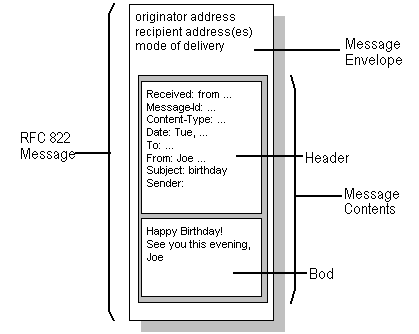About Simple Internet (RFC 822) Messages
This section briefly describes the format of the simple Internet message. For the original in-depth description, see RFC 822 itself http://ds.internic.net/rfc/rfc822.txt.
RFC 822 messages have two major parts:
- Message envelope The message envelope contains all the information needed to accomplish transmission and delivery of the message. This information includes the e-mail address of the message's creator — also known as the originator. This string matches the information in the Sender: header, if this header is present. The envelope is created by a user agent— such as Microsoft® Outlook™ — and is meaningful only to the message transfer agents that move the message on the path to its destination.
- Message contents The contents make up the object to be delivered to the recipient. Message contents consist of lines of ASCII text. This text is arranged in the classic "memo" format, in which the message contains one or more introductory headers and a body. Persons and/or applications that want to assemble or read e-mail messages using CDO use the headers and the body.
This structure can be seen in the following illustration:

You can identify the headers and body within the contents of the sample Internet mail message in the following topic.

